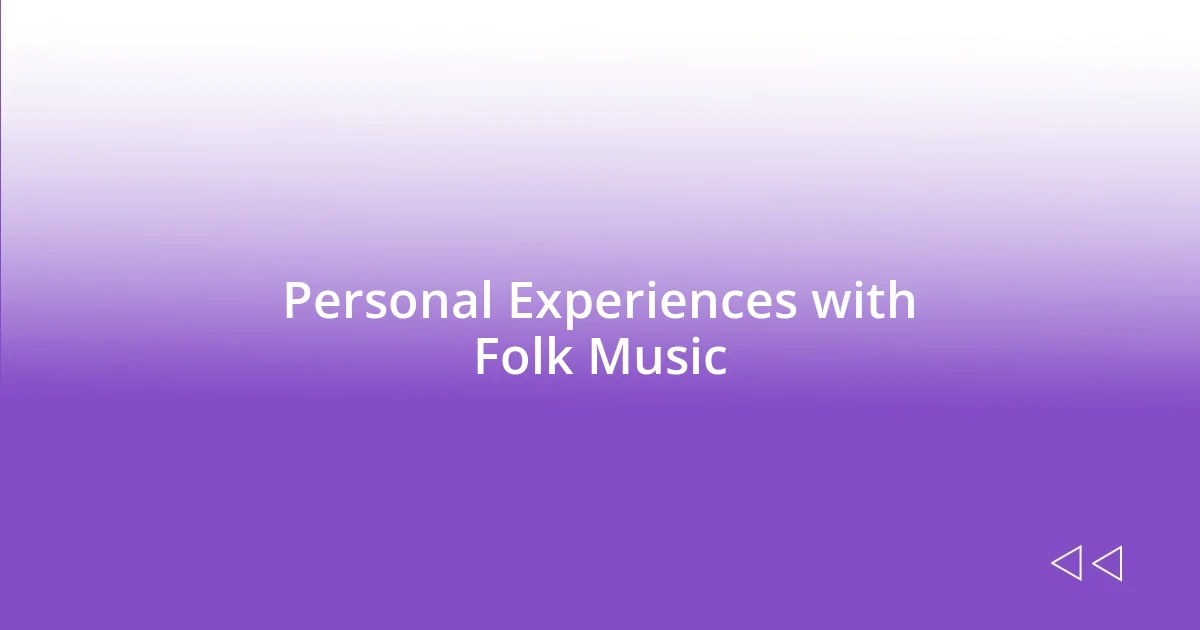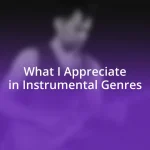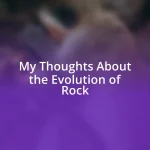Key takeaways:
- Folk music serves as a powerful storytelling medium, reflecting personal and historical experiences that connect listeners emotionally.
- Regional variations in folk music showcase distinctive rhythms, instruments, and cultural pride, creating unique communal experiences.
- Participation in folk music fosters community spirit, illustrating that the joy of music lies in shared moments rather than individual perfection.

Introduction to Folk Music Styles
Folk music is a fascinating tapestry woven from regional stories, traditions, and the lives of everyday people. I vividly recall the first time I attended a local folk festival; the melodies felt like a warm embrace, each note echoing the experiences of generations. Isn’t it incredible how a simple song can transport us to another time and place?
As I delved deeper into various folk music styles, I realized that each culture has its own unique flavor, reflecting the heart and soul of its people. For instance, the vibrant sounds of American folk can evoke a sense of nostalgia, while Celtic tunes often bring forth images of rolling green hills and ancient legends. Have you ever noticed how certain songs can instantly connect you to your roots or provoke strong emotions, even if you don’t understand the lyrics?
Every folk tradition tells a story, whether it stems from celebrations, sorrow, or social movements. I experienced this firsthand while learning about Appalachian folk music; the raw, heartfelt lyrics about struggle and resilience struck a chord with me. It’s a reminder that folk music is not just entertainment—it’s a powerful vessel for sharing human experiences and connecting us through shared histories.

Discovering Regional Variations
As I explored regional variations in folk music, I was captivated by how each style carries the essence of its community. For instance, while attending a lively bluegrass session in the Smoky Mountains, I was struck by the energetic banjo picking and the harmonious fiddles that filled the air. It amazed me how these musicians could weave tales of their everyday lives into upbeat melodies, creating a delightful connection among strangers who were gathered in appreciation of their roots.
- Different regions create distinctive rhythms and instruments, from the heartwarming strumming of the guitar in Texan ballads to the soulful sounds of the accordion in Cajun music.
- Traditional attire often symbolizes cultural pride and history, as seen in the colorful costumes worn during Irish folk dances.
- Personal stories expressed through lyrics resonate differently; for example, the blues reflecting an urban struggle often contrasts sharply with the tales of rural hardship found in Appalachian songs.
- Regional dances, like the vigorous polka in Eastern European traditions, not only celebrate the music but also encourage community bonding, allowing everyone to participate and keep the spirit alive.
Each of these regional variations tells its own unique story, echoing the experiences and emotions of the people it represents, making my journey through folk music both intimate and unforgettable.

Key Elements of Folk Music
The key elements of folk music resonate with authenticity and connection. One of the most striking aspects is storytelling, which often serves as the backbone of these songs. I remember sitting around a campfire during a folk music gathering, captivated by a singer’s tale about love lost in the midst of a great war. Each lyric painted a vivid picture that transported me into the story, illustrating just how powerful a personal narrative can be.
In addition to storytelling, instruments play a pivotal role in shaping the sound and feel of folk music. My experience in a community folk group introduced me to the sweet, melancholy sound of the violin, which often complemented the lively strumming of the guitar. The blend of these instruments created a tapestry of sound that was both grounding and uplifting. It’s fascinating how something as simple as a handmade banjo or a weathered harmonica can carry the weight of tradition and emotion.
Finally, folk music embodies the spirit of community. Participating in a sing-along at a local festival, I felt an incredible sense of belonging. Strangers became friends as we harmonized our voices, each contributing our unique interpretations of beloved songs. This spirit of togetherness is undeniably one of the most cherished elements of folk music, reinforcing the idea that while a song may belong to a single artist, it truly comes alive when shared with others.
| Key Element | Description |
|---|---|
| Storytelling | Folk songs often narrate personal or historical stories, creating emotional connections with listeners. |
| Instrumentation | Distinctive instruments like the guitar, banjo, and fiddle define the sound of different folk styles and enrich the listener’s experience. |
| Community | Folk music is a communal experience, fostering connection and unity among participants and audiences. |

Exploring Instrumentation in Folk Music
Exploring the instrumentation in folk music reveals a fascinating diversity that reflects cultural heritage. I recall attending a folk festival where a lone fiddler captivated the audience, his bow dancing with passionate precision. The haunting melodies he created lingered long after he finished, illustrating how a single instrument can evoke a wealth of emotions and memories. Isn’t it incredible how something as simple as a wooden instrument can carry legacies of generations?
In my own travels, I’ve encountered various instruments unique to their regional styles. For instance, I was enchanted by the spontaneous rhythm of a bodhrán during an Irish session, where the deep thump of the drum set the heartbeat for the lively jigs and reels. I’ve often found myself tapping along, feeling that pulse beneath my skin. This interaction between musicians and instruments creates a bond that is palpable, making every performance a shared experience, rich with emotion and tradition.
The creative use of everyday objects as instruments also stands out in folk music. I’ve seen a group of artists transform old cans into percussion, their joyous laughter filling the air as they played. It made me reflect on how folk music is about more than just the notes; it’s a celebration of resourcefulness and community spirit. Doesn’t it remind you that music can emerge from anything, bridging the gap between tradition and innovation? The vibrancy in every strum, beat, and note keeps folk music alive and evolving, tied intricately to the essence of its people.

Personal Experiences with Folk Music
Folk music has always held a special place in my heart, tied to my childhood summers spent at my grandparents’ home. I vividly remember my grandfather strumming his old guitar on the porch, while my grandmother sang sweetly about the rolling hills of their youth. Those moments were infused with warmth and nostalgia, reminding me how music can anchor us in our roots and evoke cherished memories.
One unforgettable experience was at a local folk concert where a seasoned musician shared stories alongside his songs. As he sang about his travels across the country, I felt a wave of adventure wash over me. Isn’t it fascinating how a simple melody can spark a longing for exploration and connection to distant places? His expressive performance left me in a reflective daze, thinking about the journeys I yearned to take.
During a community workshop, I had the chance to learn the basics of playing the dulcimer. I remember the initial frustration I felt as I struggled to keep up, but then something magical happened—the group began to play together. Suddenly, the shared sound enveloped us, transcending my individual clumsiness. It struck me then, how folk music is less about perfection and far more about the joy of participating in something larger than oneself. Isn’t it beautiful how music can dissolve barriers and unite us all?













